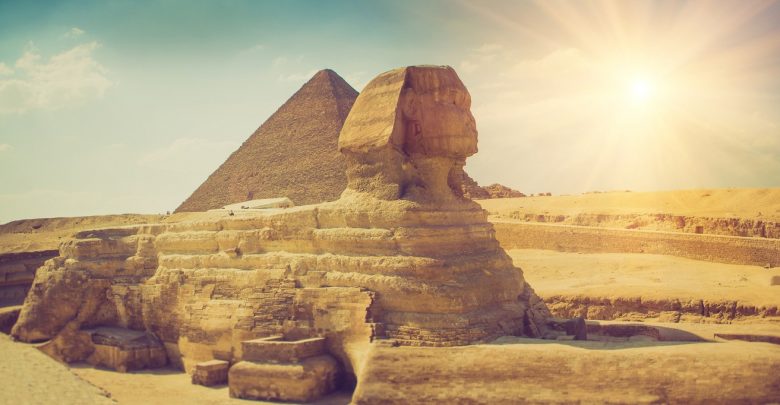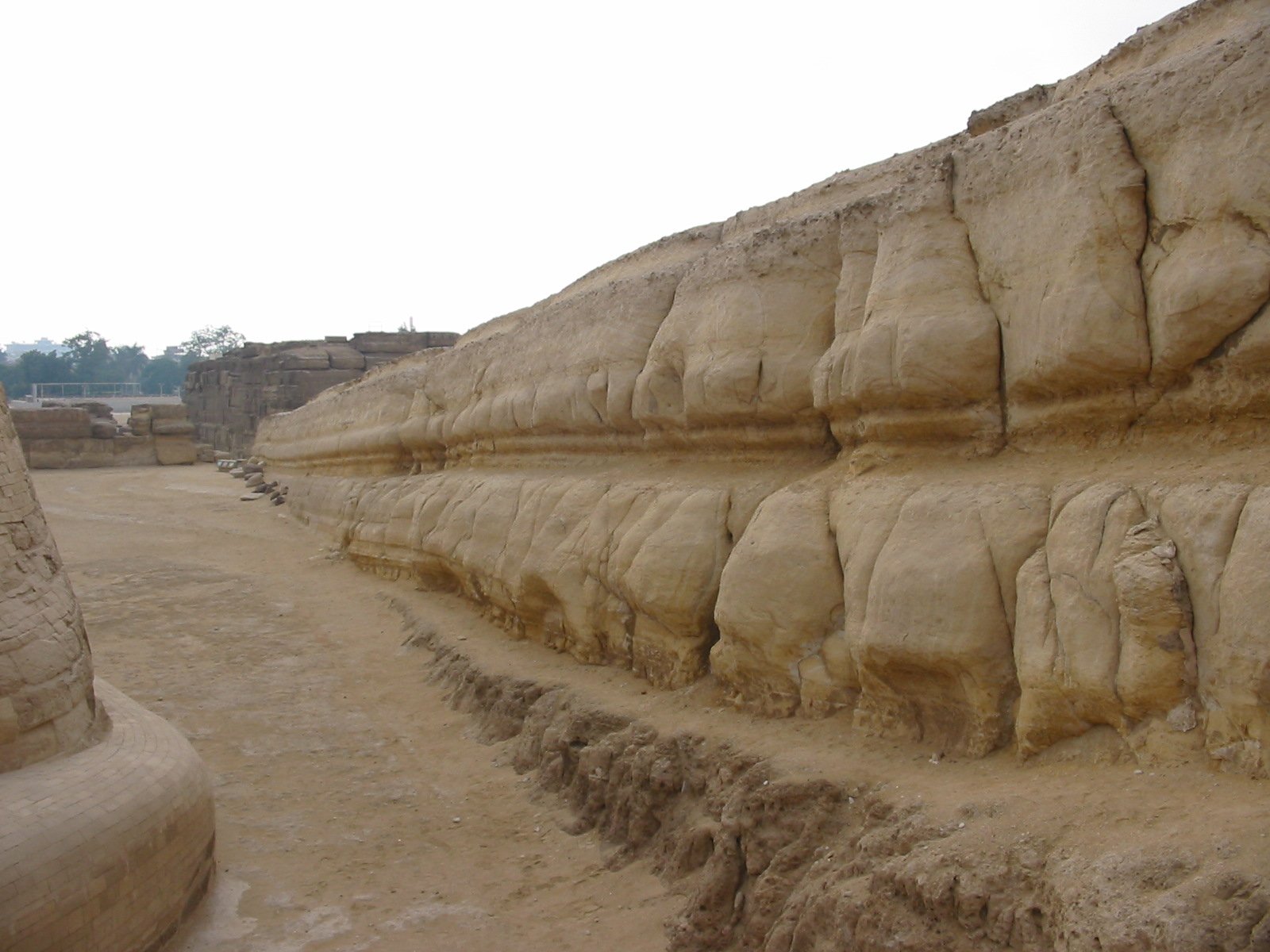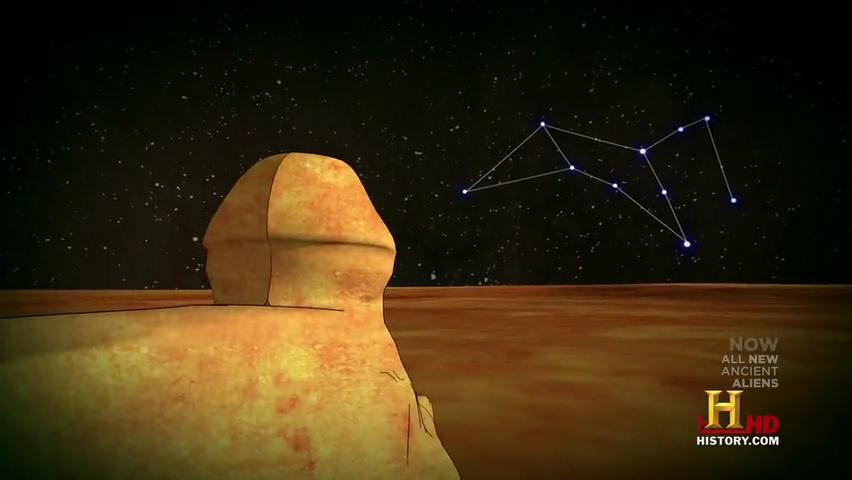The Sphinx Complex
Table of Contents

The Sphinx Complex includes The Great Sphinx, the Valley Temple, and the Sphinx Temple.
It is not known when they were built with certainty, but we can safely say that they were built with the same materials.
As a matter of fact, the Sphinx Temple was built with the limestone blocks that were carved out of the Sphinx enclosure.
Therefore, if the Great Sphinx is older than previously thought as Dr. Robert Schoch from the Boston University maintains, the temples must be older too.
The Great Sphinx
The Great Sphinx is a limestone sculpture located in the Sphinx Complex within the Giza Plateau, depicting a lying sphinx, or a mythological figure with the head of a man and the body of a lion (specifically it is called androsphinx).
Obtained from a rocky substrate, it is the largest monolithic statue among the Egyptian sphinxes: it is 73 meters long (from the tail to the front legs), 20 meters high (from the base to the tip of the head), and 6 meters wide; the head alone has a height of 4 meters.
The Great Sphinx is also one of the largest and oldest statues in the whole world, but basic facts about it are still subject to debate, such as when it was built, by whom, and for what purpose.
The main hypothesis is that it was likely built by Khafre in ca. 2500 BCE, who is also linked to the building of the Second Pyramid at Giza, because of its location in the same complex. However, Selim Hassan, who worked at more recent excavations of the Sphinx enclosure in 1949, said:
“there is not one single contemporary inscription which connects the Sphinx with Khafre; so, sound as it may appear, we must treat the evidence as circumstantial, until such time as a lucky turn of the spade of the excavator will reveal to the world a definite reference to the erection of the Sphinx”
The Water Erosion Hypothesis
This hypothesis would place the original construction of the Sphinx Complex to a bygone age, between 12.000 BCE and 10.000 BCE.
This dating refers to the “Geological Theory”, made considering the signs of vertical erosion present on the body of the statue, which typically is the result of long exposure to very heavy rains, and starting from the fact that the last rains in the desert region of Giza date back with geological evidence to the end of the last glaciation, to the period of the “Younger Dryas”.
In particular, the studies and evidence brought by many academics and especially by dr. Robert Schoch (a geophysical geologist, and Yale graduate anthropologist now professor of Natural Sciences at Boston University) proposed the explanation that the drastic climatic changes of the Younger Dryas, possibly caused by an astrophysical or planetary phenomenon, favored a long period of heavy rainfall and thunderstorms.
According to this theory, the heavy precipitations have unmistakably marked with the typical vertical percolations, resulting from very strong rains lasting for perhaps a millennium or more, both the base of the sphinx (but not the head) and the material with which the whole Sphinx Complex was built, Valley Temple included.
The material geologically consists of parallelepiped blocks of tens of tons excavated within the same block from which the sphinx was sculpted and therefore both the sphinx and the cut blocks would have been obtained internally to the original mass and therefore it is not possible that they were exposed to bad weather before construction.
To use his words: “If the granite facing is covering deeply weathered limestone, the original limestone structures must predate by a considerable degree the granite facing. Obviously, if the limestone cores (originating from the Sphinx ditch) of the temples predate the granite ashlars (granite facings), and the granite ashlars are attributable to Khafre of the Fourth Dynasty, then the Sphinx Complex was built before the reign of Khafre.”

The theory was carried forward by John Anthony West and Robert M. Schoch starting in 1992, assuming that the erosion of rain fell in times much wetter than those of the Old Kingdom between 7000 BCE and 5000 BCE.
According to the two scholars, only heavy and abundant rains could have caused the state of erosion, characterized by a wavy and arched course.
In support of their hypothesis, they compared the state of erosion of the Sphinx with some tombs of the Old Kingdom, which, despite having a poor quality rock, have not suffered such deterioration due to the sand carried by the sand wind.
Furthermore, they stated that the severe erosion of the Sphinx, still in progress today, had only begun for two hundred years and that the phenomenon of nocturnal condensation, also present in other rocky structures of Giza, could not be the main cause.
If the serious damage to the monument was due to rainwater, it was evident that it was older than the beginnings of Egyptian civilization, as only before 5000 BCE the rains in Egypt were regular, but not persistent and strong.
Schoch and West presented their work to the Geological Society of America in 1992. The geologists present were very surprised at the evidence they collected. No one thought it possible that for nearly two hundred years no Egyptologist had realized that the erosion on the body of the Sphinx is due to water, even if the Egyptologists are in fact not also geologists or geophysicists.
Schoch did not doubt that the head was from the Old Kingdom, but he believed that a pharaoh of the 4th dynasty of Egypt, if not Khafre himself, had ordered to carve his face again and restore his body by covering it with new blocks of stone.
British geologist Colin Reader, who studied the erosion patterns, noticed that they are mostly found on the western enclosure wall and less on the Sphinx itself. Thus, he proposed the rainfall water runoff hypothesis, which also takes into account climate change transitions in the area that occurred long before Khafre’s time.
Reader and Schoch also agree on the fact that the disproportionate size of the head compared to the body suggests the head of the Sphinx was originally that of a lion and recarved sometime later in the likeness of a pharaoh.
Also to be considered is the fact that, due to the earth’s precession, in 10500 BCE the Sphinx was facing the constellation of Leo (the day of the spring equinox at sunrise) and according to some scholars it was its representation.
Only later, in fact, would the lion’s head be sculpted again to represent the pharaoh: in fact, we can detect an evident disproportion between the dimensions of the sphinx’s body and those of its head and the difference in vertical erosion from rainfalls absent in the head and present on the base.
To support these statements, there is also an important archaeological find, the Stele of the Inventory.
According to what is reported on it, the pharaoh Cheops carried out important restoration work on the Sphinx.
Since Cheops was the father of the pharaoh Khafre, the original builder of the Sphinx according to the Egyptologists, we are faced with an evident paradox: how could Cheops have carried out restoration on a monument that had not yet been built during his reign?
Astronomical Correlation Of The Sphinx
The astronomical correlation theory was first maintained by authors Graham Hancock and Robert Bauval, who logically based their theory on the exact correlation of the three pyramids at Giza with the three stars forming Orion’s Belt, namely Zeta Orionis, Epsilon Orionis, and Delta Orionis, showing that these stars occupied those positions in 10.500 BCE.

It is certain that the Sphinx faces east, while the pyramids of Giza are arranged precisely according to the cardinal points.
Some scholars have focused their research on this particular arrangement, and in the 19th century, they reconstructed astronomical alignments that could have occurred in former times.
With the help of computers from the 1960s onwards the calculations were more precise. According to the astronomical hypothesis, the Sphinx would be connected to the other pyramids, and therefore built in the same period, also anticipated to 10.500 BCE.
The Sphinx, facing east, sees the sunrise every day, while only twice a year does it see the sunrise directly; it was certainly thought of as a solar monument.
Considering its divine name Horemakhet, the Sphinx would incarnate the god Horus in the form of the Sun at dawn and at sunset, thus protecting the Giza Plateau.
If over the centuries the monument has always looked towards the sun, it has not been so for the stars in the background, which have moved due to the precession of the equinoxes.
Thanks to computer calculations it was possible to reconstruct on which background of stars the sun rose over the centuries, and it is interesting to note that in 10.500 BCE it was precisely the constellation of Leo.
The supporters of this theory hypothesized that the ancient Egyptians, observing this constellation, in which we want to see a lion lying on its side, associated it with the Sphinx.
Despite the objections, this theory was carried forward taking into account the arrangement of the pyramids at Giza, which would be arranged like the stars of the Orion belt.
To reinforce this hypothesis in 10500 BC the imaginary line connecting the three pyramids from north to south pointed directly towards the celestial meridian intersecting with the constellation of Orion.
Hidden Passages Under The Sphinx Complex
One of the mysteries of the Sphinx, fueled by popular legends, is certainly the presence of hidden passages inside.
So far, the latest excavations have revealed the presence of three other tunnels in the body of the statue.
The first tunnel is located in the front, behind the stele placed by pharaoh Tuthmosis IV between the legs of the Sphinx.
The second tunnel is located on the north side (on the right for those looking at the face of the statue): its existence had long been hypothesized by observing the yellowed photos of Émile Baraize, a pioneer of Egyptology, which show workers in the act of removing sand from a tunnel.
The third tunnel was recently identified (the Egyptian archaeologist and Egyptologist Hawass entered it for the first time during the recently completed restoration of the structure); it is located near the tail and would have a depth of 15 meters.
Zahi Hawass has also stated in an interview to the Italian TV show “Freedom” that he believes that three underground tunnels connect the Sphinx Complex to the Osireion and the Great Pyramid.
Surprisingly, this would prove that the three monuments are in fact connected and that they might’ve been built during the same period of time. Therefore, if the Sphinx was built in 11.500 BCE, the Osireion and the Great Pyramids were also built in 11.500 BCE.
Last but not least, according to some (starting with the American occultist and psychic Edgar Cayce) there’s a hidden room beneath the Sphinx, called the Registry Room, that would contain all the knowledge of the ancient Egyptians fixed on papyrus scrolls, in addition to the history of the lost continent of Atlantis. We know that the Egyptians themselves considered their civilization linked to Atlantis from the testimony of Plato.
